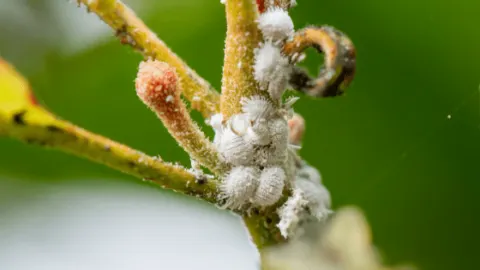You have spotted a mealybug infestation on one or multiple of your plants and want to know how to get rid of mealybugs.
What are Mealybugs?
Mealybugs are from the insect family Pseudococcidae. The Pseudococcidae family contains unarmored scale insects. They are covered in a cotton-like material, according to the University of California Agriculture & Natural Resources. This cotton-like material stops mealybugs from losing moisture. It also protects them from overheating.
Some strange white cotton material has taken over your plant. It’s everywhere. But when you look close enough, you realize it’s much more than cotton and fluff. These are mealybugs. Mealybugs are white, soft-bodied pests that look like dust. Once you look closely, you realize that they are moving.
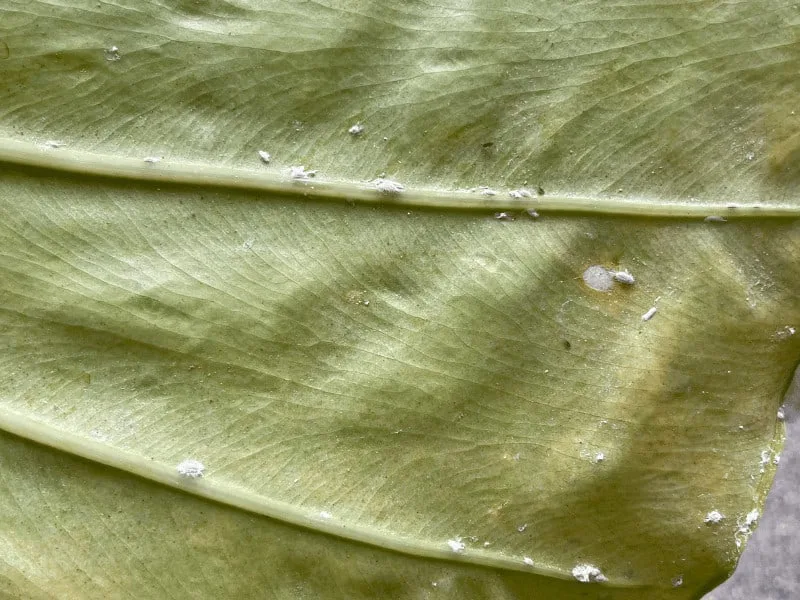
Table of Contents
How to Get Rid of Mealybugs
Detecting Mealybugs
- Visual Inspection: Examine your houseplant for signs of cotton-like fluff or waxy threads on leaves, stems, or other plant parts.
- Close Examination: Look closely at the bug under the cotton-like substance to confirm it’s a mealybug, as other pests may resemble them.
- Check Hidden Areas: Inspect under leaves and leaf folds for hidden mealybugs. Also, look for any new growth in your plant where they might be hiding.
- Symptom Observation: If the plant has yellow or wilting leaves, it might indicate mealybugs feeding off the roots. Note that other pests and diseases can cause similar symptoms.
- Check Drainage Holes: Examine the drainage holes of your plant’s pot. Mealybugs living in the soil may sometimes be found there.
- Uproot the Plant: As a last resort, carefully uproot the plant to check for mealybugs in the soil or root area. Look for their characteristic fluff balls.
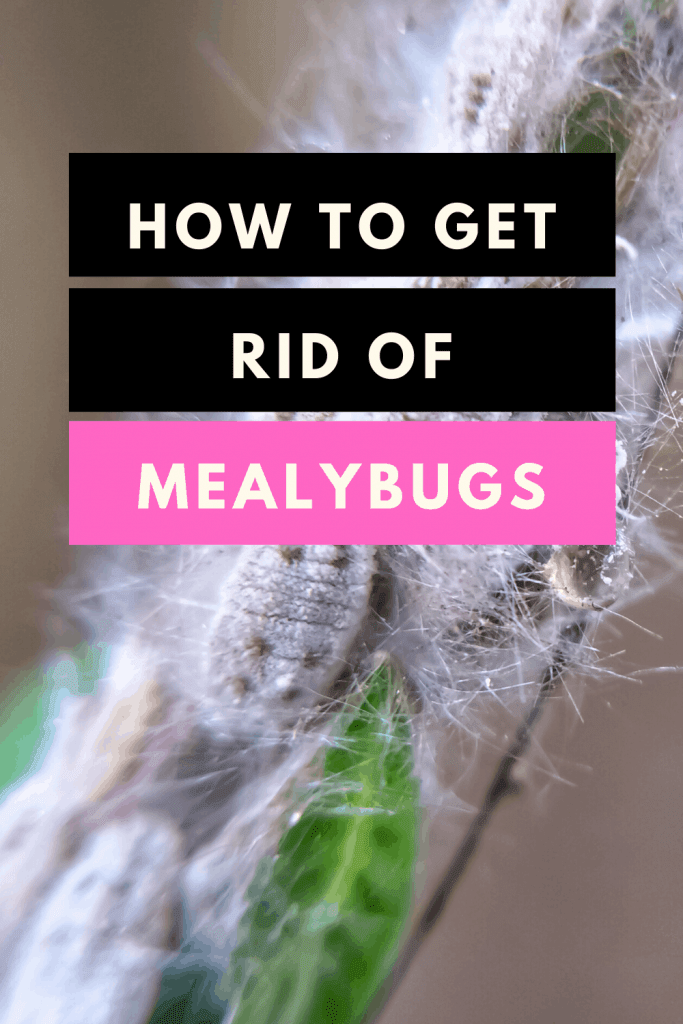
How to Get Rid of a Small Mealybug Infestation
Step-by-Step Process to Treat Small Mealybug Infestations:
- Confirm Infestation: Make sure your plant has mealybugs by checking all areas, including leaf folds.
- Preparation: Gather 70% (or less) isopropyl alcohol, cotton swabs, or cotton balls.
- Test Plant Sensitivity: A day before treatment, test a small area of the plant with alcohol to ensure it doesn’t burn the leaves.
- Apply Alcohol: Soak a cotton swab in isopropyl alcohol and dab it onto each visible mealybug. Try only to touch the bugs and not the plant.
- Weekly Treatment: Repeat the alcohol treatment once a week for several weeks to ensure all mealybugs and any hatched eggs are eliminated.
- Alternative Method: If concerned about alcohol damage, dilute it with warm water or use a high-pressure water spray to dislodge the mealybugs for manual removal.
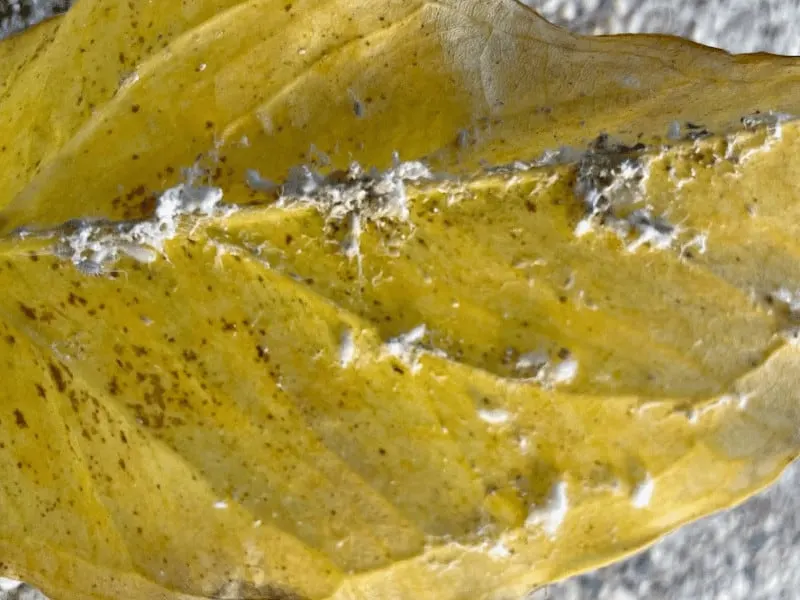
Step-by-Step Process to Treat Large Mealybug Infestations
- Assess Severity: Determine the extent of the mealybug infestation on your plant.
- Pruning: If feasible, prune infested branches or leaves and dispose of them immediately.
- Initial Treatment: Use the water spray or isopropyl alcohol method on the remaining plant parts.
- Insecticidal Soap: Consider using insecticidal soap containing potassium salt and fatty acids. Test on a small area of the plant first.
- Application: Spray the insecticidal soap thoroughly, ensuring it directly contacts the mealybugs.
- Repeat Treatment: Apply the soap multiple times, checking daily for mealybugs and reapplying as they reappear.
- DIY Insecticidal Soap: Optionally, use olive oil, mild dish detergent, and warm water. Use a clean spray bottle for application.
- Horticultural Oils: Consider using natural horticultural oils like neem oil, which can suffocate bugs and their eggs.
- Chemical Treatments: As a last resort, you may try chemical pesticides, which are often less effective due to the mealybugs’ waxy coating.
- Removal: If the infestation is too severe and other methods have failed, you may need to dispose of the plant to prevent spreading to other plants.
Following these steps, you can take comprehensive action against large mealybug infestations.
How to Get Rid of Mealybugs on a Jade Plant
Inspect your plant closely to get rid of mealybugs on a Jade plant. If the infestation is small, you can pluck and squish the mealybugs by hand if you are not grossed out. Alternatively, use a paper towel or a Q-Tip drenched in rubbing alcohol. For larger infestations, use a mix of Neem Oil diluted in water. Alternatively, mix a few drops of dishwater soap and rubbing alcohol diluted in water. Use a spray bottle to apply it.
Male and Female Mealybugs
Most mealybug species have projections. This makes it seem like they have double the legs, like an optical illusion. It can confuse people to see if their plant has these pests. Male mealybugs are oval, and they do have wings. They also have two long filaments. It’s rare to see male mealybugs on a plant.
Their only purpose is to fertilize the female mealybugs. And they don’t live for very long. They only live for about two to three days. Female mealybugs are round and wider than males. And they don’t have wings like their male counterparts. They grow to be around 1/16 inch long (0.16 cm).
There are 275 different mealybug species in the United States. The most common species is the citrus mealybug, or Planococcus citri. They’re also the most common mealybug found in household plants.
Other mealybug species include grape mealybugs, long-tailed mealybugs, obscure mealybugs, and vine mealybugs. These bugs are attracted to several types of plants, including gardenias. But their favorite plants are succulents.
How Mealybugs Reproduce
Most mealybug species lay eggs to reproduce. However, the sizes can differ from species to species. These eggs are usually covered in that cotton-like substance you see on the bugs.
For example, female citrus mealybugs can lay up to 600 yellow eggs. These eggs are about 1/100 of an inch in size. They’re difficult to see with the naked eye.
The female spins the fluffy material around the eggs for protection. They’re trying to hide the eggs from predators. The female will die five days after the female mealybug lays the eggs. They hatch a week to two weeks after the mealybug lays the eggs. There will be crawlers or nymphs.
The new crawlers move on to tight spaces to feed off a plant. They dig into the plant. During this phase, they won’t leave their feeding area.
The nymphs also sneak away to find a place to feed. They take four to eight weeks to grow into their adult form.
If they go a full 24 hours without feeding, they will die. They’re very vulnerable in this state. A group of mealybugs will go through two to five generations yearly. That’s a lot of mealybugs looking for food.
The long-tailed mealybug (or the Pseudococcus longispinus) doesn’t lay eggs. Instead, the eggs hatch when the female long-tailed mealybug lays them. Then, they release the crawlers. After five days, the long-tailed females will die as well.
Some species can reproduce asexually. They don’t need another mealybug to create and lay eggs.
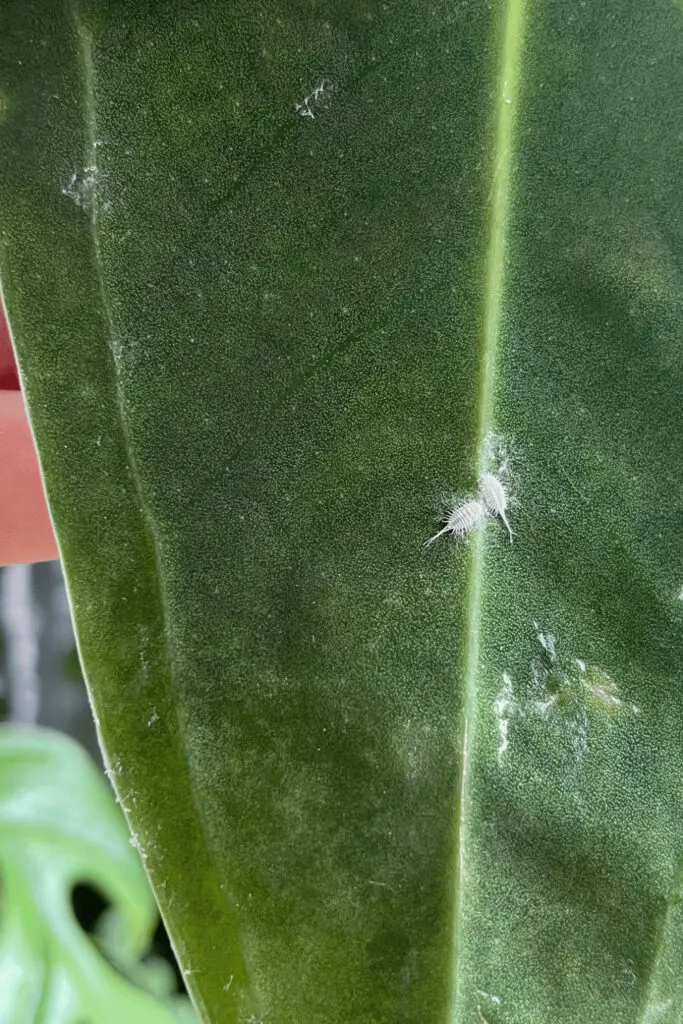
How Mealybugs Attack Your Plant
Mealybugs are plant pests with two common traits: they feed in clusters and suck sap from plants. The sap is vital for the plant’s hydration and nutrient transport, like animal blood. Without it, the plant can’t undergo photosynthesis, leading to stunted growth, yellowing, wilting leaves, and potentially death.
Mealybugs also excrete substances that can lead to mold growth on the plant. Different species target different areas of the plant, such as stem tips, leaf-stem junctions, or roots. While a few mealybugs may not be harmful, their rapid breeding can lead to severe infestations that should be treated immediately.
How to Prevent Mealybugs
It’s always best practice to prevent pests when you can. You want to stop them before they invade your houseplant. You can’t prevent everything, but you sure can try.
The first step to preventing mealybugs is to check every new plant you bring into your home. Check before introducing it to your other plants.
You also want to keep them separate from your older plants for at least two weeks. This is to ensure the new plants don’t have any bugs to pass on to other plants.
If the new plant does have mealybugs, it’s easy to spread the pests to your other plants. They’re able to crawl across branches and leaves to other close plants.
This is something you need to be wary of. Don’t over-fertilize your plant. Fertilizers with high amounts of nitrogen can start a new plant, which mealybugs love. They’ll lay eggs around the new growth.
Keep your plant 100% healthy. It’s the best way to protect your houseplant from these annoying pests. They like to attack weak or stressed plants.
If you have an infestation in one of your plants, move it from your other plants to prevent them from spreading.
You can put it in another room or on your porch if it’s separated from the healthy plants.
Black Sooty Mold
Mealybugs can lead to black sooty mold. The mold can make your plant sick.
So, it’s important to treat the mold and the plant. You can use a high-pressure spray. It’ll remove all the sooty, loose mold, and spores.
You can use a mix of mild dish detergent and distilled water for any mold that doesn’t come off. Using a spray bottle, cover any area with mold with the mix. Don’t be afraid to use the spray. You want the areas soaked well.
Now, you can spray the plant with water once more to remove the soap mix. The mold should come off with it. Trim off any areas that still have mold.
FAQ
Is my jade plant susceptible to mealybugs?
Mealybugs love jade plants. Keep your plant healthy and monitor it to prevent these critters.
What’s the life cycle of a mealybug?
The life cycle of a mealybug is 30 days. This is why treating your plant one to two times a week is important until they’re all gone.
Can I use insecticides to get rid of mealybugs?
You can use insecticides on mealybugs, but it should be a last resort. Ensure you’re using an insecticide for indoor plants because of the fumes.
Why do I have mealybugs and ants?
When mealybugs feed on a plant, they excrete a sugary honeydew as waste. This attracts ants. Once you get rid of the mealybugs, the ants will disappear.
Conclusion
A mealybug infestation is nasty and something now plant parent or avid gardener wants to deal with. Once you spot them, the goal is to get rid of mealybugs as fast as possible so the infestation doesn’t get bigger, and swap over to other plants in your houseplant collection or garden.
The best way to prevent mealybugs is to check on your plants regularly and look closely to see if you spot any webs or small insects.
With this guide, you have all the possible remedies and knowledge on how to get rid of mealybugs.

Daniel has been a plant enthusiast for over 20 years. He owns hundreds of houseplants and prepares for the chili growing seasons yearly with great anticipation. His favorite plants are plant species in the Araceae family, such as Monstera, Philodendron, and Anthurium. He also loves gardening and is growing hot peppers, tomatoes, and many more vegetables.

